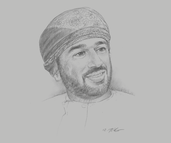Abdulrahman Al Hatmi, CEO, Oman Global Logistics Group (ASYAD): Interview

Interview: Abdulrahman Al Hatmi
What will be the key growth drivers of the transport and logistics sector for the next decade?
ABDULRAHMAN AL HATMI: Creating efficiencies, offering economies of scale and providing integrated solutions across the logistics value chain will be key differentiators for Oman over the next decade. The sultanate’s commercial environment is improving and will certainly benefit international customers. According to the World Bank’s “Doing Business 2020” report, Oman ranks first in the region in terms of trading across borders, offering the fastest clearance times in the GCC, a result which helped raise our ranking by 10 positions in the ease of doing business index.
Oman’s natural geographic advantages will also play a role. Situated directly on the main east-west trade route, Oman offers fast access to regional and global markets. For instance, goods transported from Oman can reach the US within two weeks. This proximity significantly reduces costs and working capital, and instead of travelling through the Strait of Hormuz, vessels that call at Oman’s ports can save up to four days in transit time – reducing fuel costs by up to $250,000 per trip. Oman’s neutral relations with countries is another salient growth factor, and manufacturing businesses benefit from preferential market entry through 40 international trade and investment agreements across Asia, Africa and the Indian sub-continent.
To what extent can Oman capitalise on its transport infrastructure to attract foreign direct investment in the agriculture and fisheries sector?
AL HATMI: Oman’s port facilities and integrated multi-modal freight options are supporting the fisheries sector. New freight-forwarding capabilities, as well as new cold storage and distribution assets, are expected to nearly double fisheries production to 480,000 tonnes per year and create 20,000 jobs. Around 160 agricultural, livestock and fisheries projects in the private sector, worth an estimated $2bn, are also under way. Furthermore, ASYAD is developing trade partnerships with Central Asian countries such as Uzbekistan to cement Oman’s position as a global centre for agricultural goods.
Targeted investment in agricultural technology and research and development has led to global recognition of the sultanate’s agricultural potential at the UN Conference on Trade and Development. Advanced food technology initiatives are set to improve self-sufficiency, and increase the production and quality of food manufacturing. Ultrafiltration and reverse-osmosis desalination are also being utilised, and 10 new desalination plants are set to be operational by 2023. How do you assess the Port of Duqm’s freight and cargo capacity as it reaches operability, and how does this translate into benefits for investors?
AL HATMI: The Port of Duqm is crucial to expanding Oman’s integrated logistics offering. It is already emerging as one of the GCC’s most competitive and efficient logistics centres. The port facility hosted over 100 vessels in 2018, with increasing business coming from the competitive dry bulk, oil and gas, roll-on/roll-off, and bunkering segments. Duqm is already Oman’s leading break bulk and over dimensional cargo operator, and plans to leverage its 2200-metre commercial quay and 18-metre draft to become a mixed-used port.
As the Port of Duqm nears full operational status, stakeholders are set to benefit from enhanced infrastructure including a new $8bn road network, a planned rail connection and Duqm Airport, which officially opened in January 2019. The Oman Drydock Company, located at the Port of Duqm, offers a number of ship maintenance and conversion facilities, and repair services. In addition to the steel works industry, it also serves the petrochemicals sector.
You have reached the limit of premium articles you can view for free.
Choose from the options below to purchase print or digital editions of our Reports. You can also purchase a website subscription giving you unlimited access to all of our Reports online for 12 months.
If you have already purchased this Report or have a website subscription, please login to continue.

